The Adelaide Art Scene: Becoming Contemporary 1939-2000
The Adelaide Art Scene is much more than an attractive book … This is as much a cultural history as it is an art history, and the range of its authors necessarily means that its multiple voices and perspectives deliver a fascinating depth to a regional history.
READ REVIEW
↓
The Adelaide Art Scene:
Becoming Contemporary 1939-2000
Margot Osborne (ed.) | 2023
It is difficult not to be impressed, maybe even intimidated, by the heft and weight of The Adelaide Art Scene. At 744 pages it is at a quality of production rarely seen these days. Published by Wakefield Press with full colour illustrations on an attractive paper stock, as a physical artefact it is a pleasure to hold and use. Its design and layout provide a volume simultaneously elegant, simple and clear. At $120 it is, on these grounds alone, remarkably reasonably priced. It has evolved from a collaboration with Guildhouse, South Australia’s peak visual art and design organisation, Carrick Hill, the Art Gallery of South Australia and the South Australian government. While this level of partnership is not uncommon in the cultural sector, what is unusual is the sheer scale, size and ambition of The Adelaide Art Scene. Indeed, it is difficult to think of anything else published recently that compares to it in terms of scale and quality. It is worth noting, too, the quality of the colour reproductions. Printed on a sympathetic matt stock, the colour – particularly for oil paintings – seems noticeably clear and sharp. This really matters for books about art.
However, The Adelaide Art Scene is much more than an attractive book. Compiled by Dr Margot Osborne, a respected and prolific South Australian art historian, the book brings together essays by seventeen writers who each focus on various aspects of South Australian art history from 1939 to 2000. By engaging with this timeframe through essays devoted to subjects and themes broadly anchored to particular decades, the book eschews a typical linear narrative, documenting the progress and development of South Australian art. While this strategy is effective, in the overlapping nature of the content of many of the essays and their common themes, an overarching sense of a consolidated – even if somewhat fragmented – history is evident.
Osborne has incorporated some interesting and especially useful (and in some respects old-fashioned) features in the book. ‘From the archives’ reproduces significant texts selected from essays, reviews and catalogues published between 1939 and 2000. These texts, denoted by a thin, coloured stripe (different for each decade), convey the tenor and concerns of each period, often in ways that the essays themselves cannot. The book concludes with selected biographies of 120 South Australian artists. These two features, now rarely seen in contemporary art histories, are resources that help cement this book’s value as an essential reference work for anyone thinking about recent South Australian art history.
Osborne is keen to engage with the idea of Adelaide as a both an avant-garde and a provincial city, which has for generations struggled with a sense of itself as both sophisticated and isolated, never sure whether it was cultured or second-rate. But as Osborne points out, and as the essayists reveal, this kind of binary history ignores the actual complexities of South Australian society, which was of course enmeshed within a larger Australian context, and which flourished and thrived on the constant flow of creatives in and out of the state. The Adelaide art scene always intersected with what was happening elsewhere in Australia, and while there were of course regional complexions, it was never a fortress of isolation.
This is not a book which will ever be read in one sitting, cover to cover. The Adelaide Art Scene is more a book for the reference shelves. Yet that is not to diminish its value. It is as much a cultural history as it is an art history, and the range of its authors necessarily means that its multiple voices and perspectives deliver a fascinating depth to a regional history.
The Adelaide Art Scene: Becoming Contemporary 1939-2000 is published by Wakefield Press.
Reviewer: Richard Neville, PHA (NSW & ACT)

